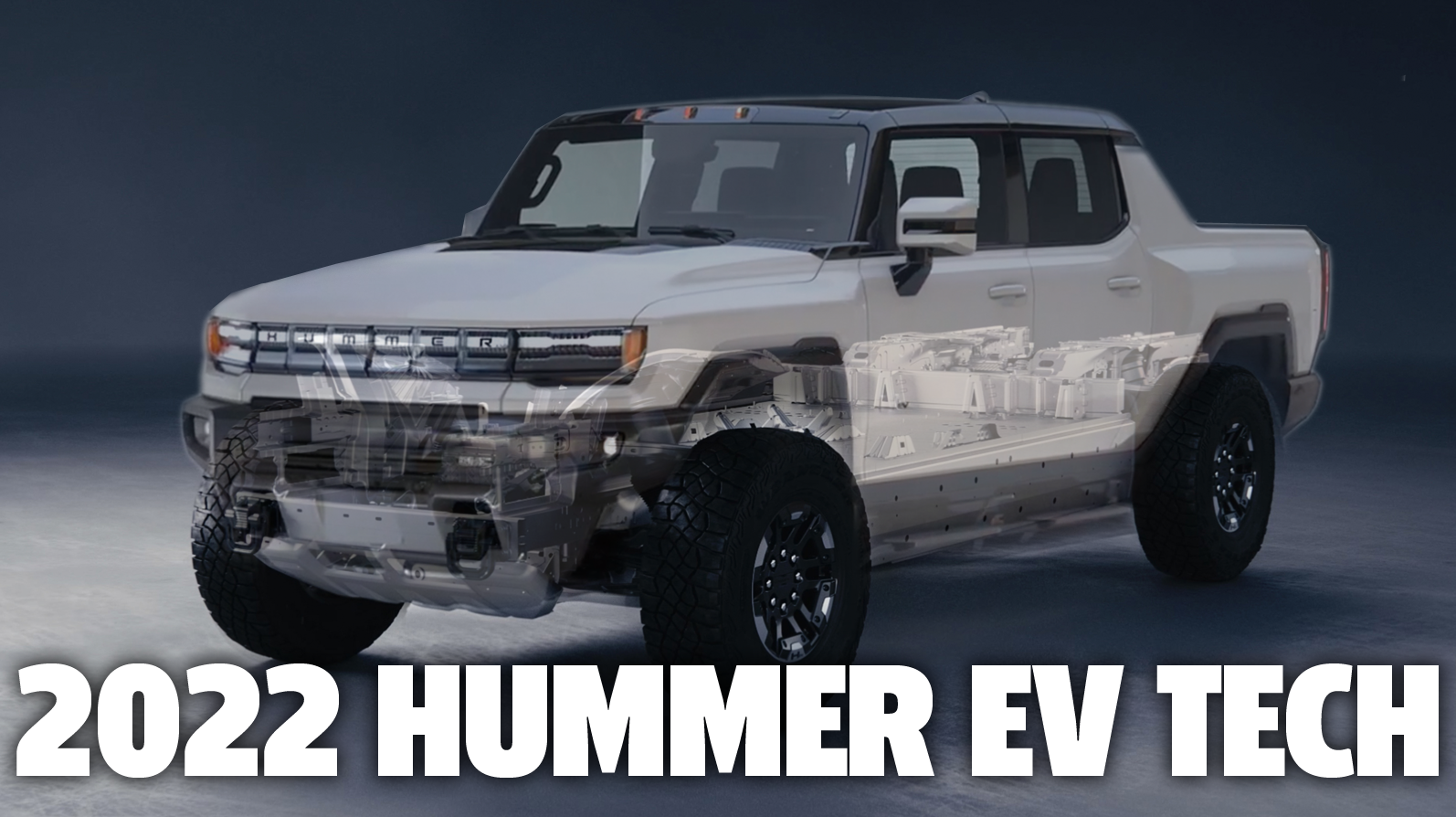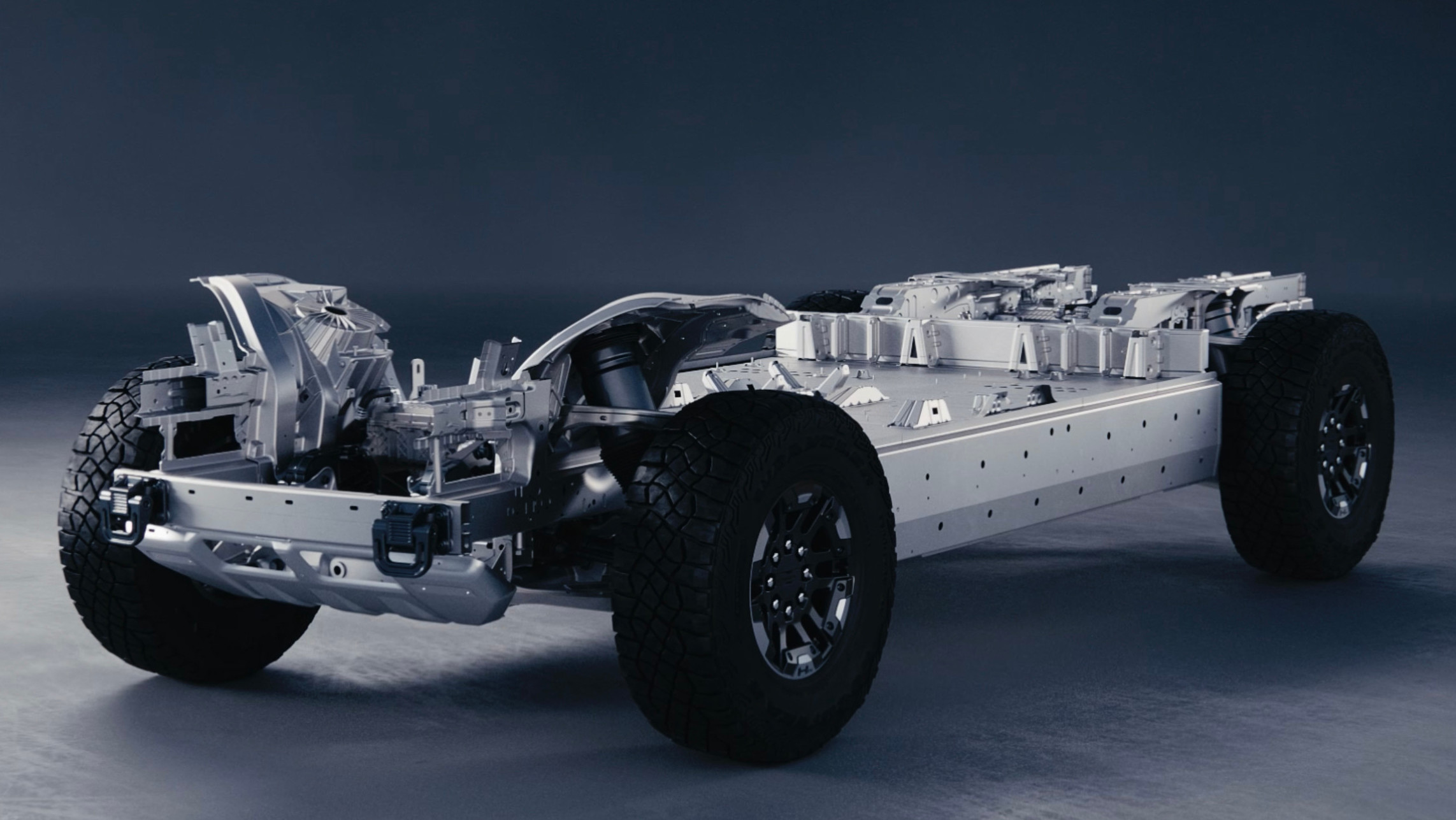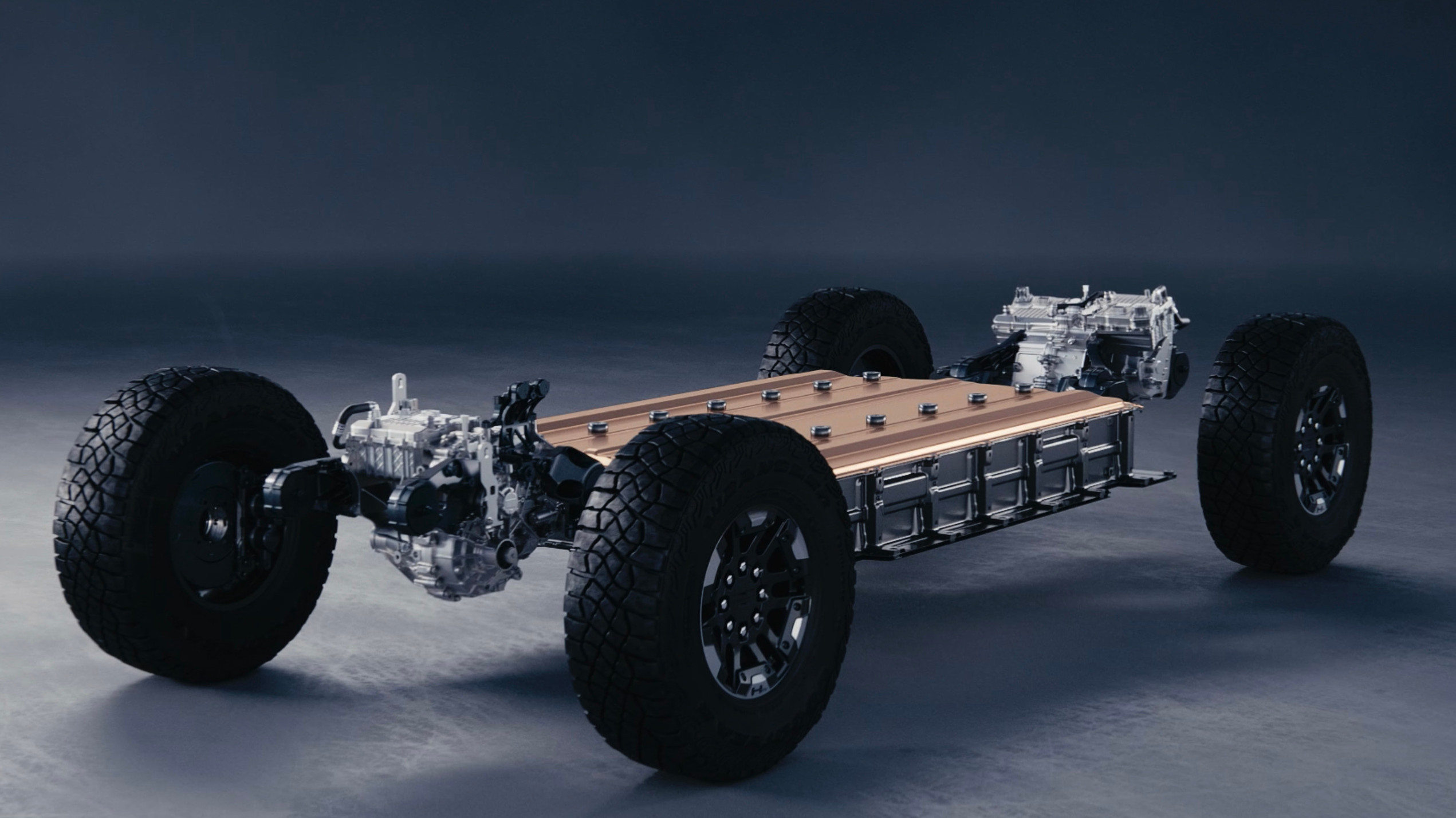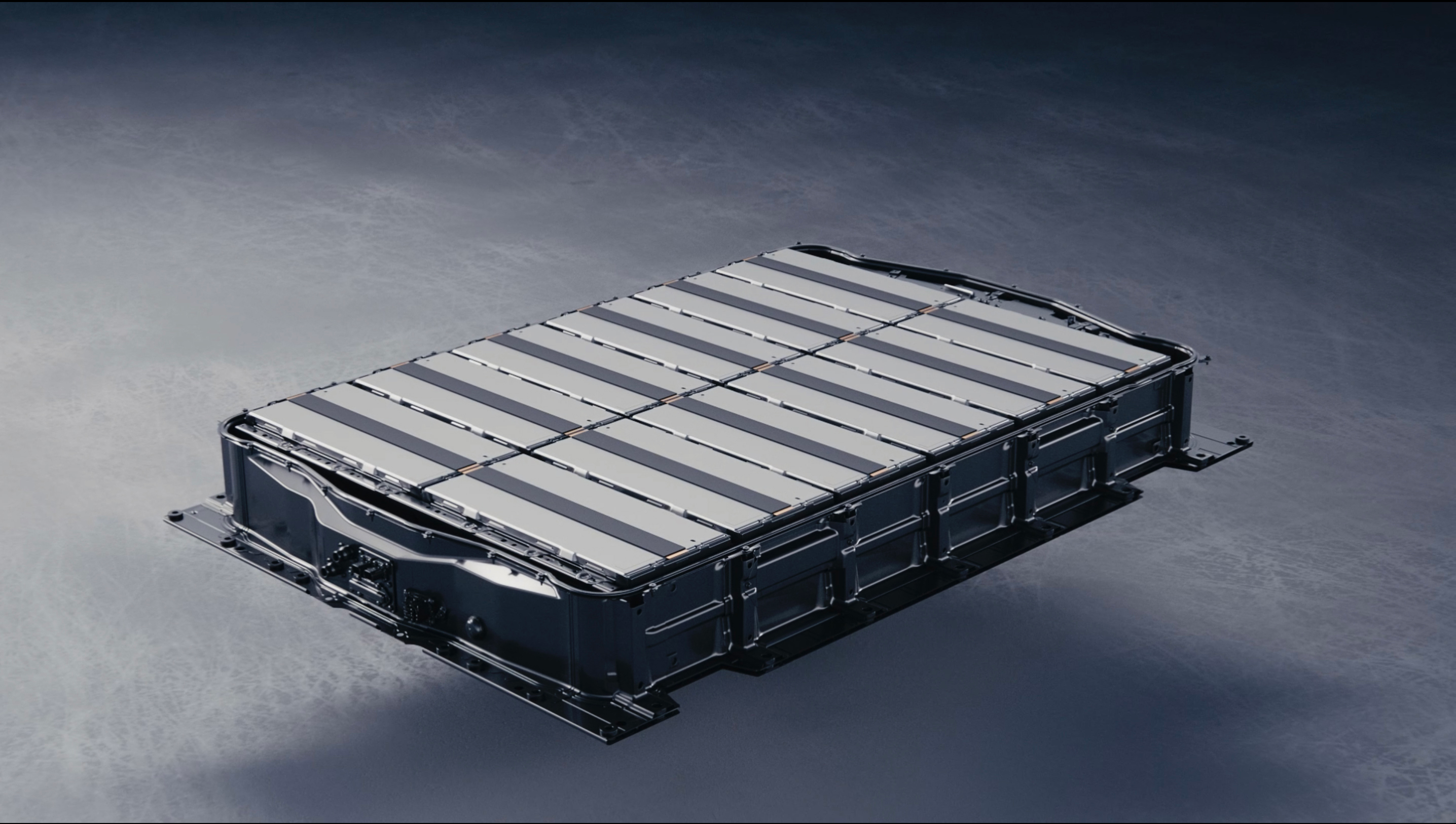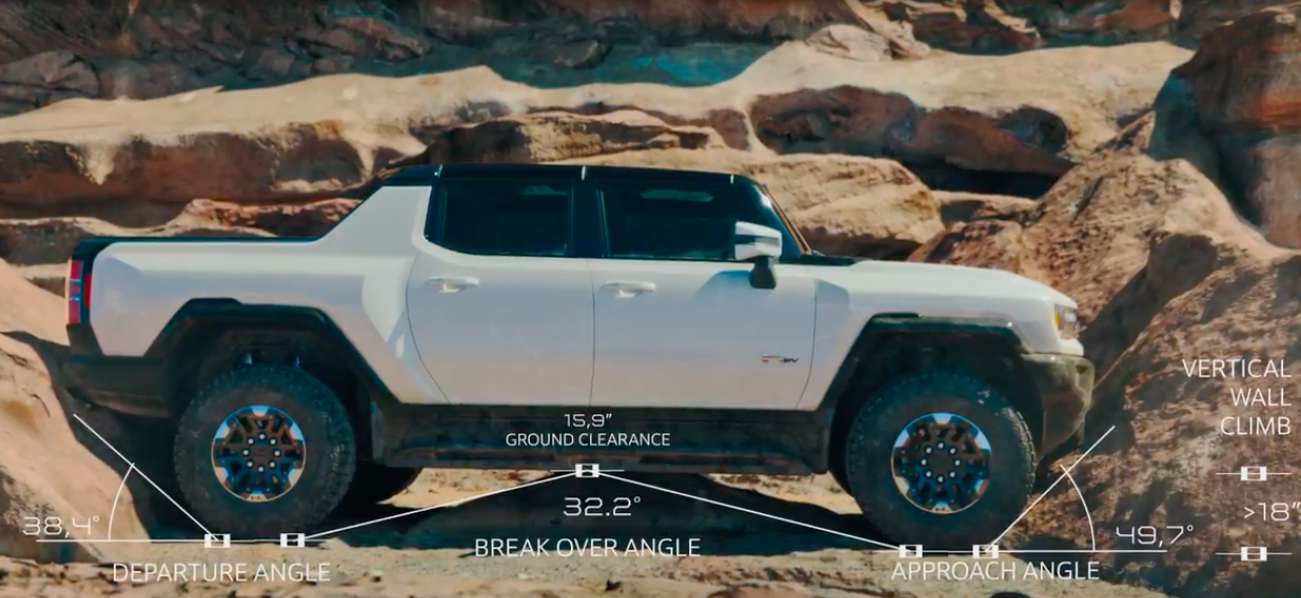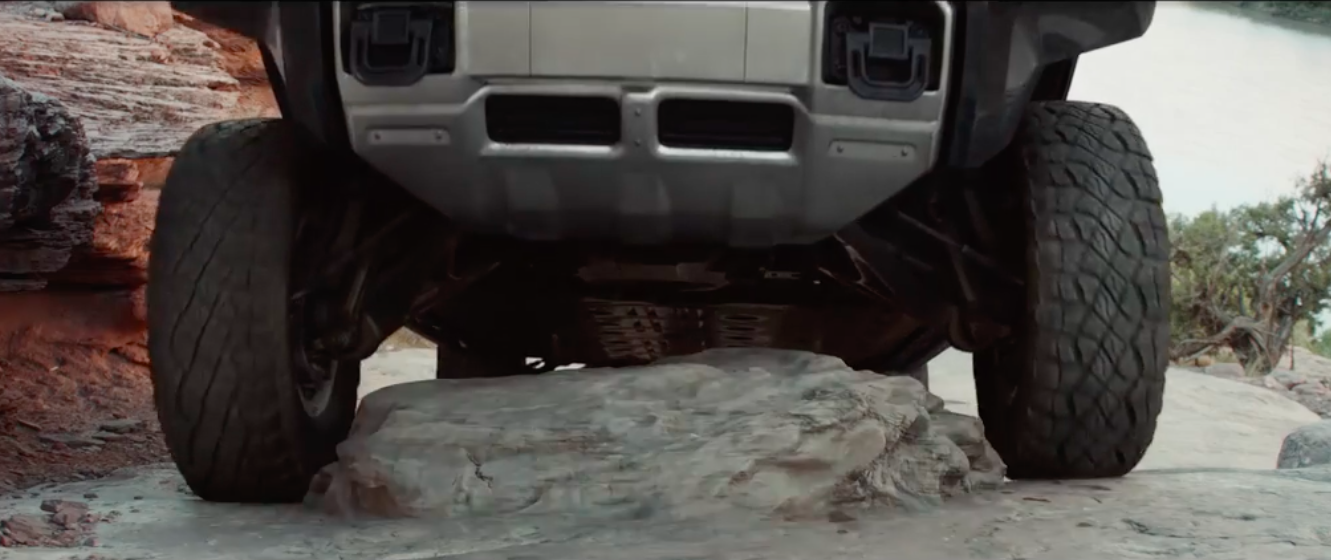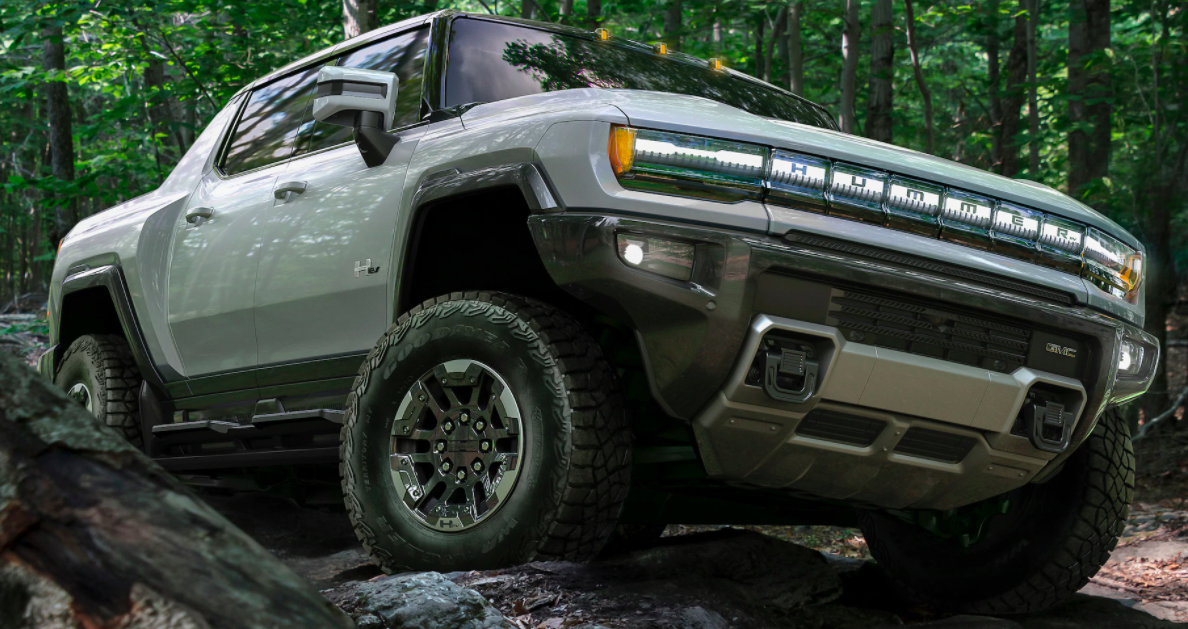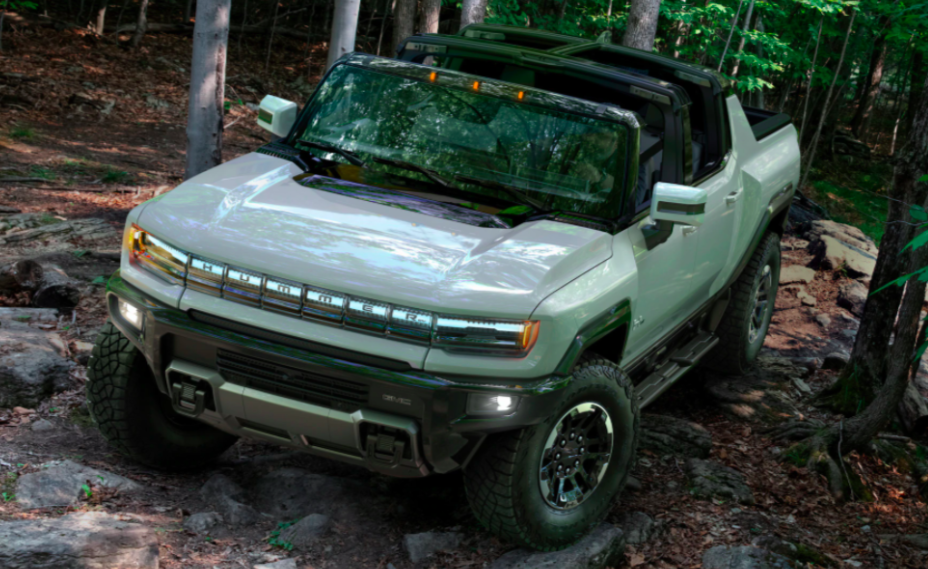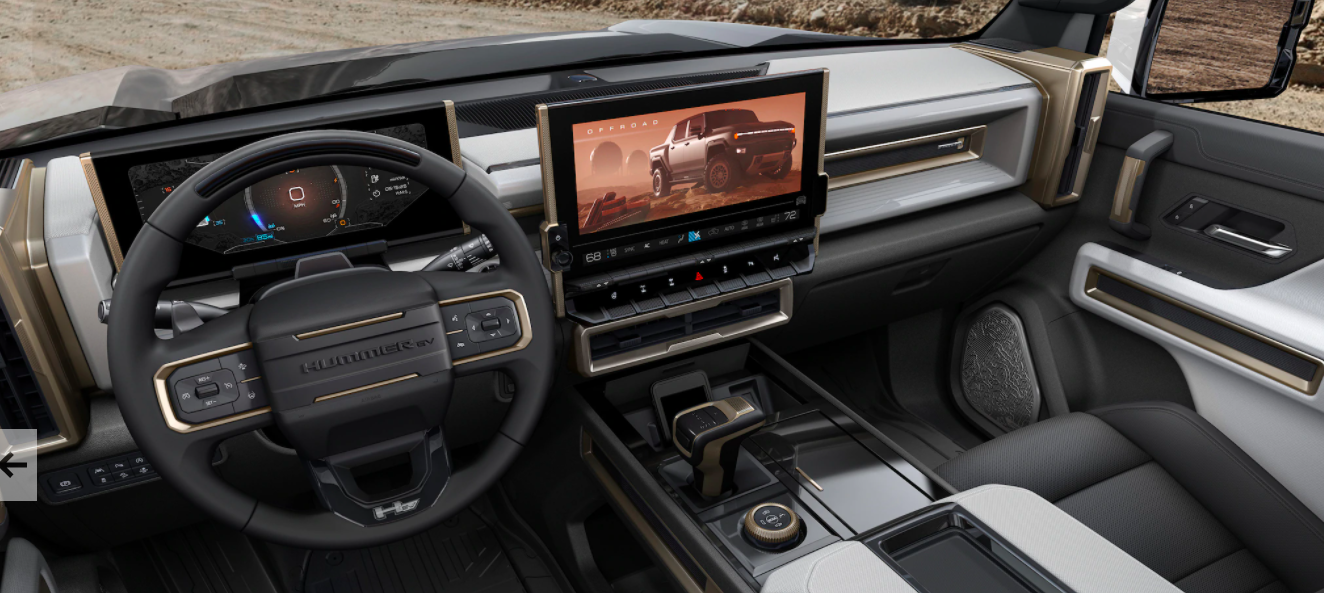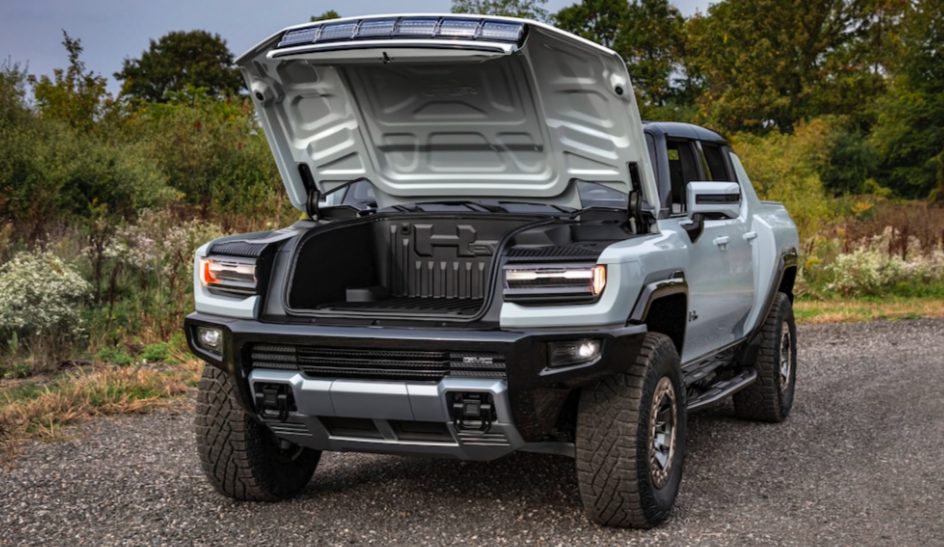A Close Look At The Tech Behind The 2022 Hummer EV
General Motors just debuted the first production-intent Hummer in more than a decade, but instead of it being an enormous, gasoline-sucking machine like the Hummer you remember, it's an advanced EV. Here's a look at some of the Hummer EV's coolest tech.
In general, when I write technical deep-dives I include discussions with engineers. But GM hasn't made its engineers available to me yet, so I'll have to go full-on hadal later. No worries though, because this shallow-dive is filled with plenty of exciting tech.
Let's start with the basics.
Body and Chassis
The Hummer EV is built on a "skateboard"-style platform similar to what underpins many electric vehicles these days. Making up the backbone of the architecture is a large battery tray (which appears to be aluminum), with what looks like cast aluminum front strut mounts and suspension mounting points, some stamped front rails and multipiece lower "frame" rails. It's hard to tell, but one of my engineer contacts noted what look like self-piercing rivets and MIG stitch welds on the main front rails.
I'll get to the bottom of the body design when I chat with GM engineers, but for now here's what the company has in its press materials:
An all-new structure eliminates conventional frame rails, which would raise the center of gravity, and makes the battery pack a fundamental structural element of the chassis. It is protected by sturdy shear panels above and below the double stacked batteries, while an exceptionally rigid floor above the battery pack helps the body resist twisting, even with the Sky Panels of the Infinity Roof removed.
The suspension fastened to that platform is a double-wishbone, fully independent setup with air springs. Steering is a dual rack-and-pinion arrangement, which makes Hummer EV's four-wheel steering possible. Note that a number of other automakers offer four-wheel steering, but unlike many of those, the Hummer EV does not simply turn the rear wheels left and right through its rubber bushings. Instead, the Hummer's rear suspension actually has ball joints to allow for a full 10 degrees of rotation.
Here's a look at the setup:
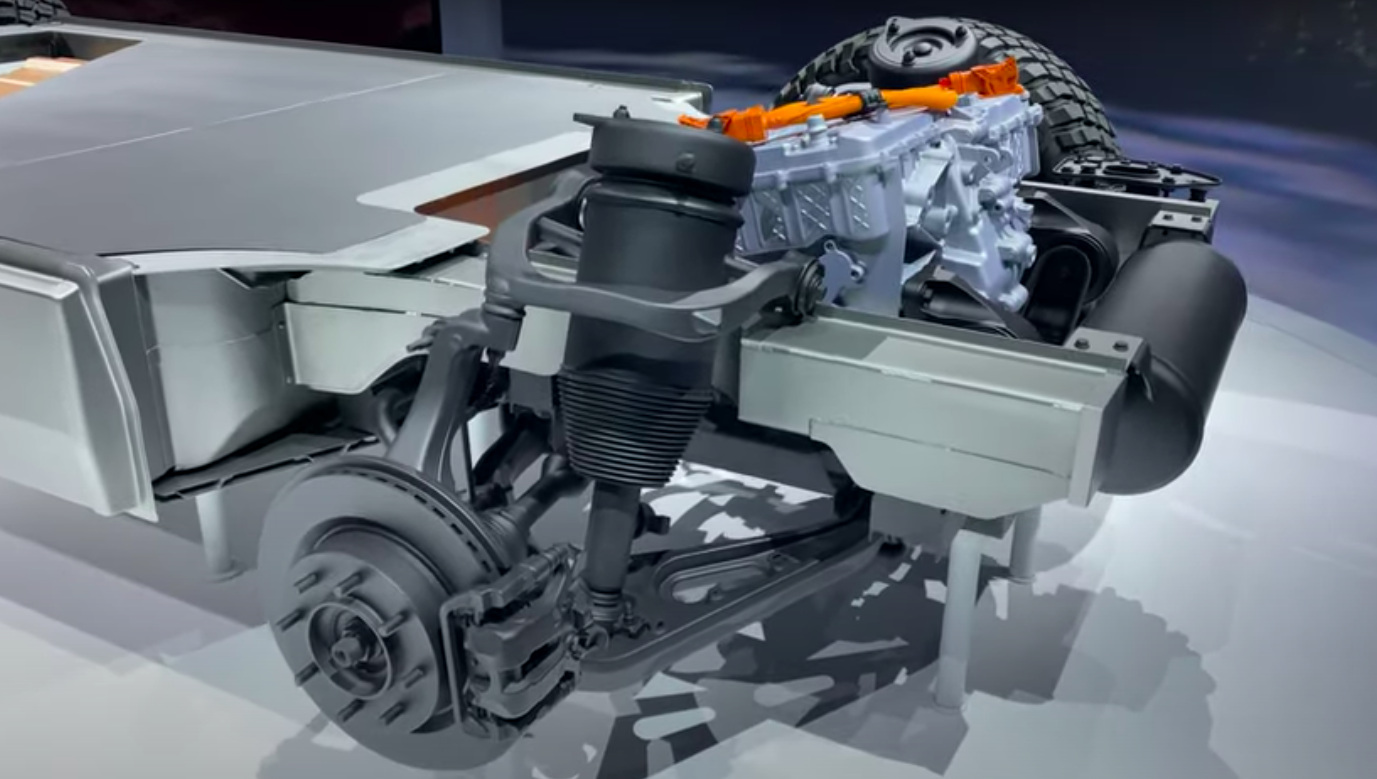
I haven't seen any close-up images of the design, but the operating principles seem similar to GM's Quadrasteer, developed by the supplier Delphi, introduced on the 2001 GMC Terradyne Concept and ultimately put into production for the 2002 GMC Sierra Denali. Here's a look at that design:
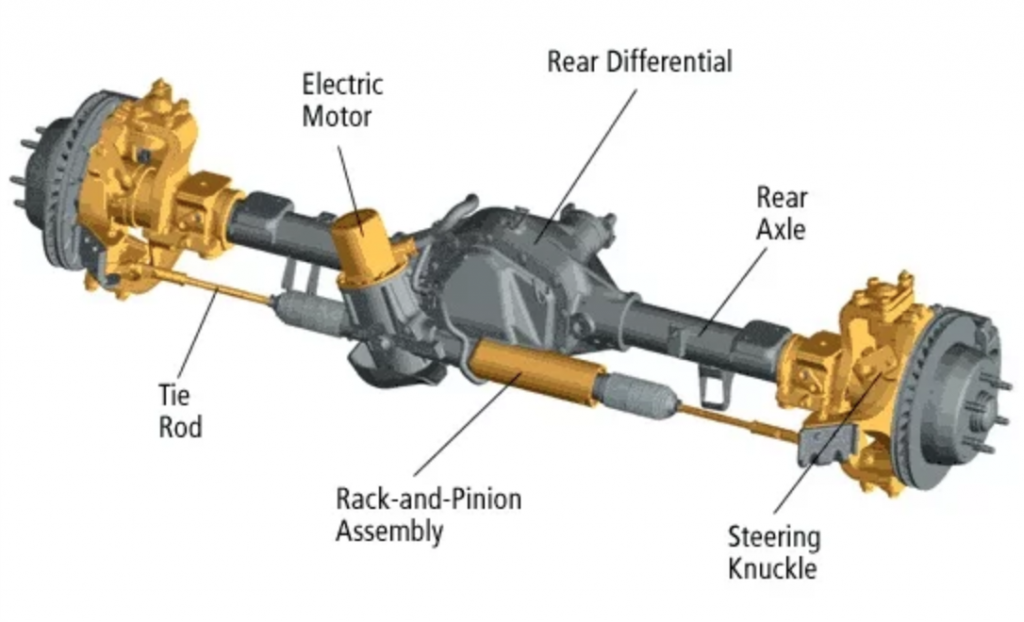
For reference, the Porsche Cayenne's rear steering setup does not have ball joints, but just flexes the rear "knuckle" about its rubber bushings. This is fine, since maximum rear steering angle is only three degrees:
As mentioned in the Porsche video above, at high speeds the front and rear wheels turn in the same direction to provide stability during highway lane-changes, while at low speeds the front and rear axles turn in opposite directions to reduce the turning circle radius for better maneuverability.
The Hummer does this, too, and also offers a mode called CrabWalk, which steers the front and rear axles in the same direction at low speeds. Hummer calls CrabWalk a "revolutionary available setting utilizing HUMMER EV's 4-wheel steering...to drive diagonally at low speeds, helping it to traverse tight trails with a capability that no other truck in its segment can match."
I definitely wouldn't call it "revolutionary" (again, it seems quite similar to GM's Quadrasteer), but I'll give the company credit for finding a unique and marketable way to use the capability already available in a four-wheel steering system.
Motors And Drive Units
The top-spec Hummer EV shown in all the debut press images has a system called e4WD, which comprises two permanent-magnet AC motors (each rated at 250 kW, or 335 HP) independently driving the rear wheels and one 250 kW motor powering both the fronts, with all three motors combining for a claimed 1,000 horsepower and 11,500 lb-ft of wheel torque (not to be compared to motor/engine torque of traditional ICE vehicles).
As is always the case with production EVs, the motors don't drive the wheels directly but instead send torque through a gear reduction, which reduces the motors' output speed (angular velocity) but increases output torque. This provides improved off-the-line acceleration without severely limiting top speed, as electric motors can rotate at speeds well above 10,000 rpm.
Per GM's press release, the gear reduction for the rear motors is 10.5:1, while the gear reduction up front is 13.3:1. Basic algebra, as noted in a video from Engineering Explained (embedded later in this story), lands us at roughly 335 lb-ft of torque for each motor.
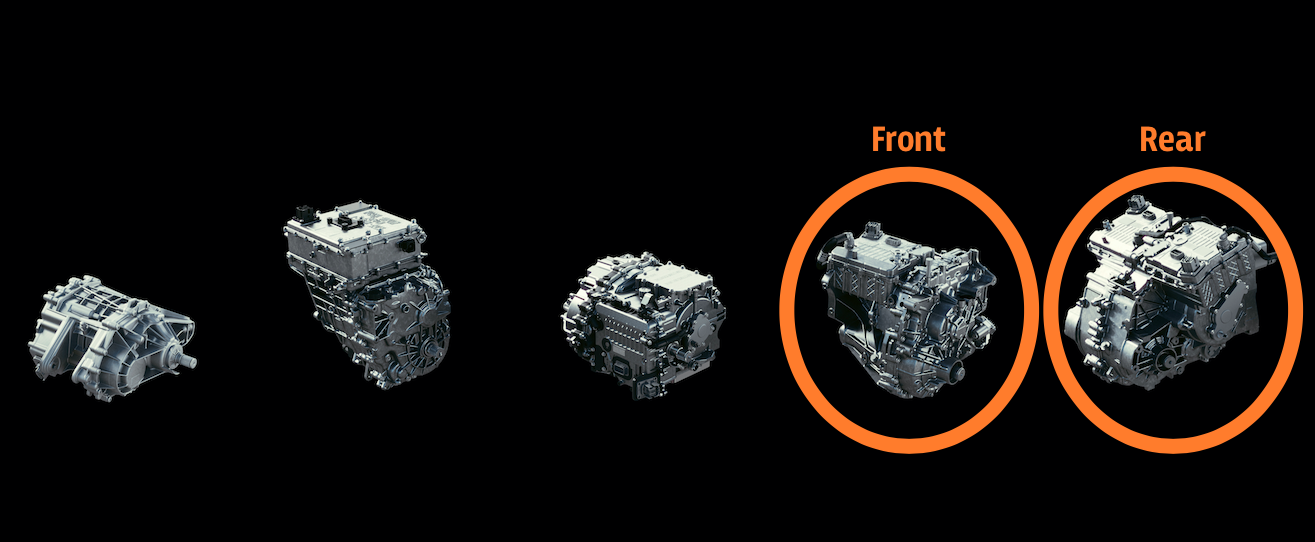
The two rear motors, packaged in a single aluminum housing but independently controlling the rear wheels, are shown at the right in the image above, while the front motor is shown just to the left of that. These are all part of five distinct drive units (consisting of three different motor types) called Ultium Drive, which GM says will power a number of upcoming vehicles.
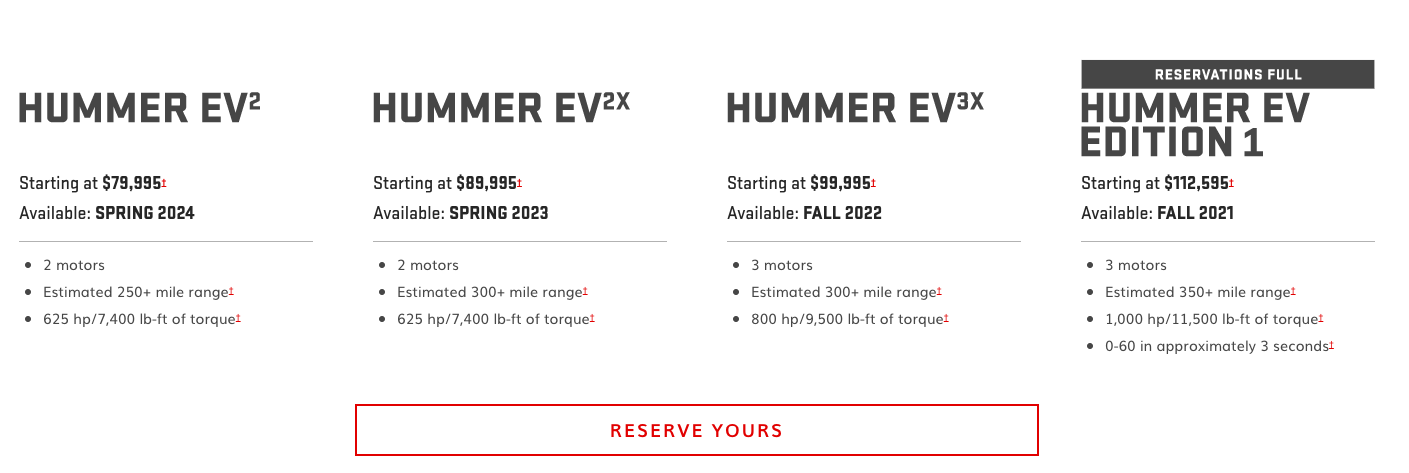
So far, we've only discussed the Edition 1 trim level, which starts at over $110,000. Lower trims don't offer the same 1,000 horsepower, 11,500 lb-ft (at the wheels) output. The next trim down, the EV3X, makes 800 horsepower and 9,500 lb-ft at the wheels, and the EV2X and EV2 lower trims each make 625 horsepower and 7,400 lb-ft of wheel torque.
I'm not certain, but it seems that the EV exponents for the trim levels represent the number of electric motors followed by an X, which seems to correspond to range (perhaps X for "extended range"). So the EV3X has three motors and 300 miles of range, the 2X has two motors and 300 miles of range, and the 2 has two motors and 250 mile of range.
It's not clear based on the literature I've seen, but I'd guess that the 2 and 2X models will use — in both the front and rear — the same drive unit found in the front of the Edition 1.
Batteries And Charging Tech
It may not be surprising to hear that the Hummer EV's battery pack is enormous. That's because, EV or not, there's a certain amount of energy required to propel a large, aerodynamically barnlike SUV down the road. This means that to achieve the same range as a smaller, slipperier car you need a bigger battery, which adds weight, which means more energy is required to move the car — it's a tricky, circular situation.
Watch the clip above to see the basic layout of the battery pack. It consists of two stacked layers of 12 modules (they're not literally stacked; there's a separator between the two), with each layer containing two rows of six modules.
Inside each module, Jason Fenske from the YouTube channel Engineering Explained writes, are 24 vertically-oriented rectangular pouch cells co-developed by GM and LG Chem. Watch Engineering Explained's video below to see a rundown of how they're connected; the short of it is that in each module are eight sets of three pouches connected in parallel.
With batteries connected in parallel, voltage is not additive (current is). This means that three 4.2-volt batteries (we'll assume that each pouch cell has a roughly 4.2 volt max voltage, though nominal voltage is usually around 3.7) connected in parallel yield a set of three cells that still has a voltage of 4.2 volts.
But voltage in series is additive. So when you connect eight sets of three parallel cells in series, you wind up with 4.2*8=33.6 volts in each module. Since there are 12 modules in series each "stack" of the battery pack, that amounts to roughly 400 volts per stack. The two stacks are oriented in parallel, so voltage of the overall pack is still 400 volts.
You can do similar math using knowledge of each cell's capacity to arrive at over 200 kWh for the entire battery pack. Per Engineering Explained, GM confirmed a pack size of over 200 kWh, or roughly twice the size of a Tesla Model S Long Range Plus battery pack.
The Tesla, despite having less than half the battery capacity of the Hummer EV, actually offers more range, possibly because GM restricts access to the full 200 kWh as a way to ensure battery longevity. (We don't know if this is the case; I'll ask. Many automakers limit access to full battery capacity though Tesla famously does not). Other factors contributing to the two vehicles' range disparity could be differences in motor/battery/control system efficiency, and then the big one is of course the delta in "vehicle demand energy" (i.e. energy needed to propel the vehicles due to their size difference).
The cells themselves are NCMA, which describes the nickel, cobalt, manganese and aluminum constituent elements of each cell cathode. GM promotes its Ultium battery tech as offering big jumps in power density and significant reductions in cobalt use, with GM claiming "70 percent less cobalt than GM's previous generation of EVs."
Reduction of cobalt in batteries has been a goal of pretty much all automakers, including Tesla (see Elon Musk's tweet above). It's not just about reducing battery cost, but there are also environmental and human-rights benefits to cutting out cobalt. You can read more about that here.
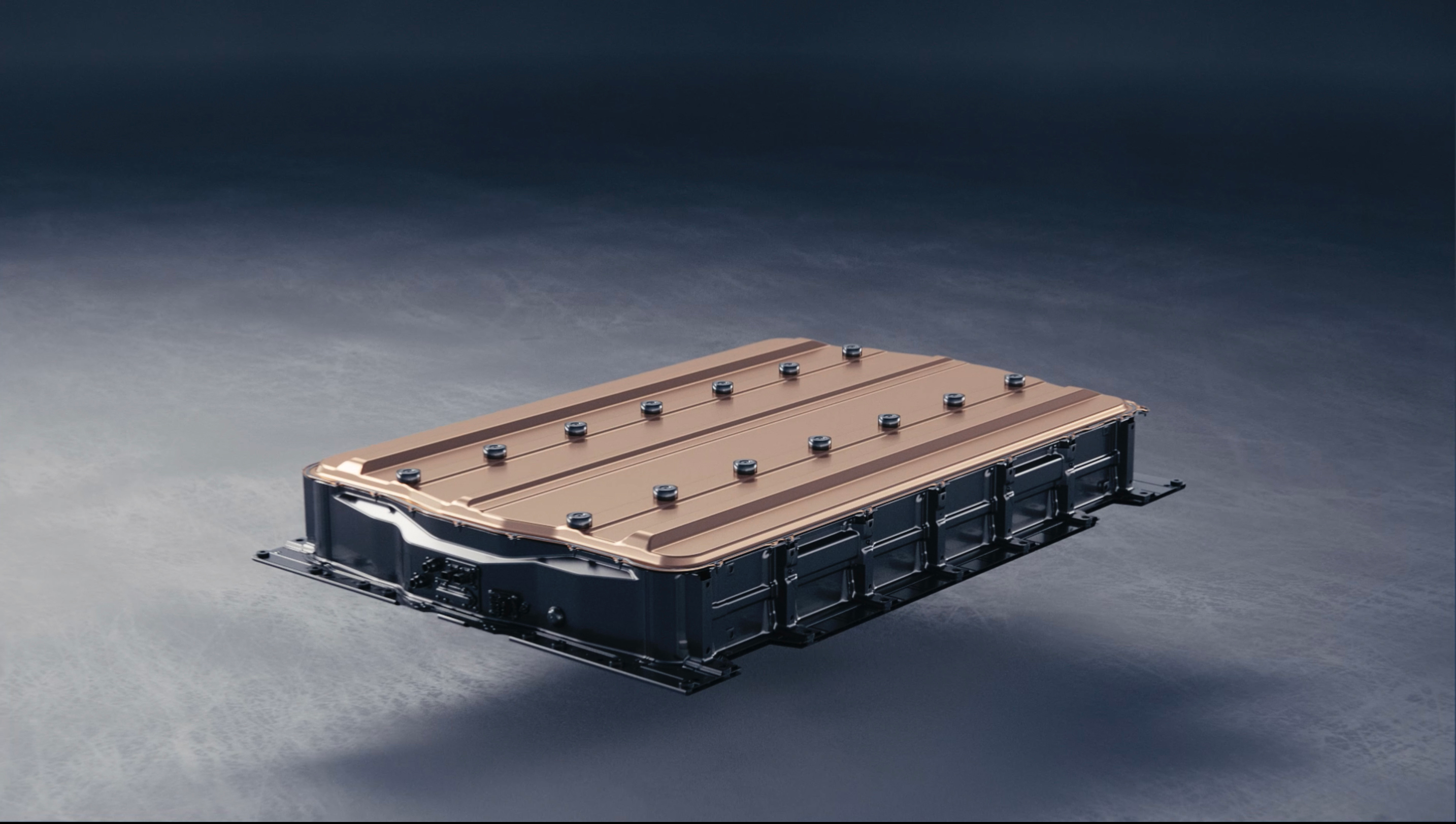
As for charging, GM says the Hummer EV can use 350-kilowatt DC fast chargers thanks to clever switches in its battery pack that place the upper stack of modules — which normally operates in parallel with the lower — in series with the lower. This brings overall pack voltage to 800 volts, from 400.
This is roughly the same pack voltage as the Porsche Taycan, whose engineers mention the high pack voltage as a major enabler for quicker charging times and the adoption of smaller, lighter wiring. (To achieve the same power with a higher voltage means lower current, which is good because losses in wiring go up with current squared.)
Note that the Porsche's max charging power is 270 kW, which enables a recharge from a 5 percent state of charge to 80 percent in 22.5 minutes. It's not clear what the Hummer's true maximum charging rate will be, but we do know that GM claims that the vehicle can "add nearly 100 miles of range in 10 minutes of charging."
GM discusses charging in its press release, writing:
The Ultium battery system will control the electrical currents at the charging station via clever algorithms that ramp down the current and switch to the other half of the pack, when necessary, and increase the rate of charge. The charging system is also designed to support legacy 400-volt charging infrastructure, without the need for a converter box or other accessories allowing HUMMER EV to use a variety of charging stations.
GM says it has found a way to reduce battery pack wiring and to reduce overall complexity among its vehicles by designing a battery management system that allows the modules to "talk" to one another wirelessly to do things like balance battery cells' state of charge. Per GM:
HUMMER EV will also be the first vehicle in GM's lineup to feature its wireless battery management system, which maintains balance within the truck's battery cell groups for optimal performance and battery longevity.
Green Car Reports describes the benefits of such a setup, writing:
The layout allows GM to scale its technology across different models and brands, with different cell and module configurations, without redeveloping the wiring and communications protocols each time, GM says. It also makes secondary applications and battery reuse much easier, versus wired systems, as it wouldn't require a redesigned battery management system. And it reduces wires within the battery packs by up to 90 percent, permitting a cleaner design.
But to make the system future-proof, the wireless system enables GM to introduce new battery chemistries in the future to production models by merely changing out the modules. It might also permit owners, perhaps, to swap out their modules for advanced ones with more energy density in the future — because the new modules would come with their own new calibration for the wBMS.
Off-Road Performance
Let's talk about off-roading, since this is a Hummer, after all.
The single most important characteristic of any capable off-road vehicle is advantageous geometry. That means lots of ground clearance, short overhangs and a small, high belly that won't get caught up on crests, boulders, or downed trees.
In these areas the Hummer EV excels relative to even the most capable off-roaders. The table below shows many of the Hummer EV's off-road specs; I've circled the most important ones.
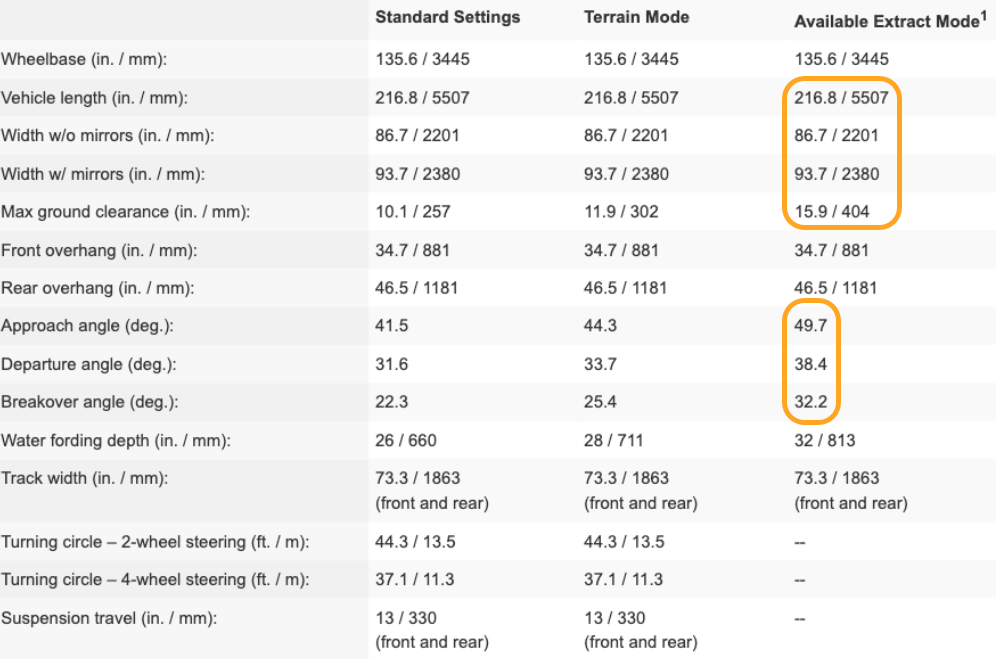
Dimensions
The Hummer EV offers an Extract Mode (see below), which GM describes as a feature that "enables the suspension height to be raised approximately 6 inches, in order to help the HUMMER EV negotiate extreme off-road situations such as clearing boulders and fording deeper water."
As I understand it, this is basically just maxing-out the air suspension, which could help one get out of a tricky situation. It probably isn't a setting you'd want to use otherwise, since downward suspension travel will likely be almost zero.
Still, it seems useful, and in this setting the Hummer EV — with its 35-inch Goodyear Wrangler mud-terrain tires — has 15.9 inches of ground clearance, an approach angle of 49.7 degrees, a departure angle of 38.4 degrees and a breakover angle of 32.2 degrees.
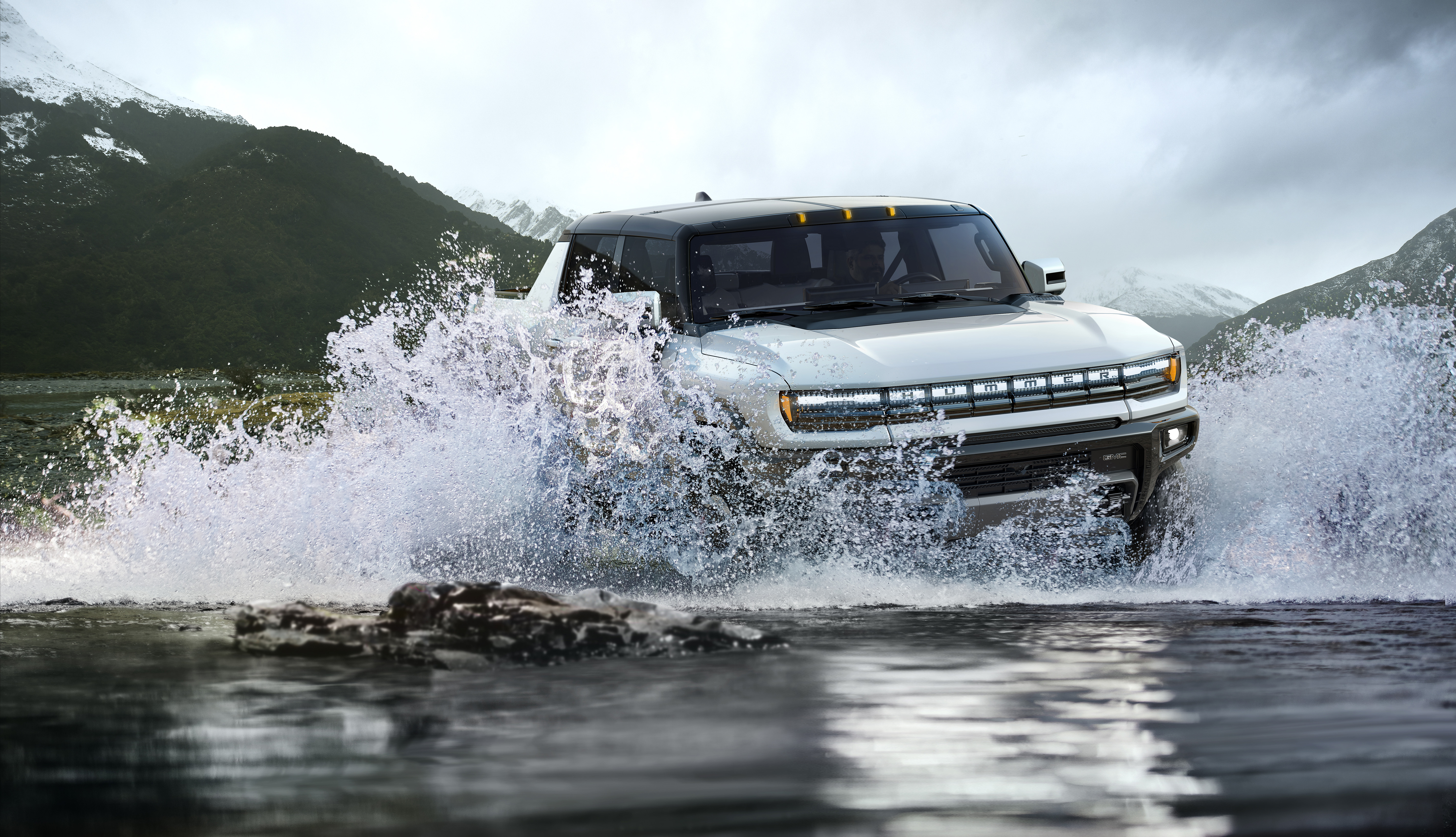
For comparison, the Jeep Wrangler Rubicon Unlimited has a 44 degree approach angle, 37 degree departure angle, 22.6 degree breakover angle and 10.8 inches of ground clearance.
The Land Rover Defender 110, also equipped with air suspension, has a 38 degree approach angle, 40 degree departure angle, 28 degree breakover angle and 11.5 inches of ground clearance.
And the Ford Bronco's approach, departure, and breakover angle are 43.2 degrees, 37 and 26.3, respectively. Ground clearance for the Blue Oval's new off-road is 11.5 inches.
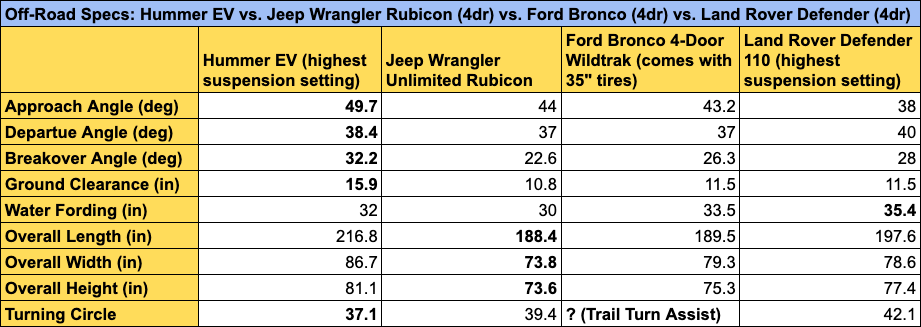
You'll notice that I've just compared the Hummer EV pickup to SUVs, which are known to be better off-road due to their more compact dimensions.
Indeed, when you look at exterior dimensions, the Hummer is significantly longer than the rest of the pack (and it's also much wider and taller). And yet, its off-road angles are favorable — this is impressive, even if the bed is only five feet long. Speaking of which, here's a look at that bed, which can be equipped with GMC's Multi-Pro tailgate.
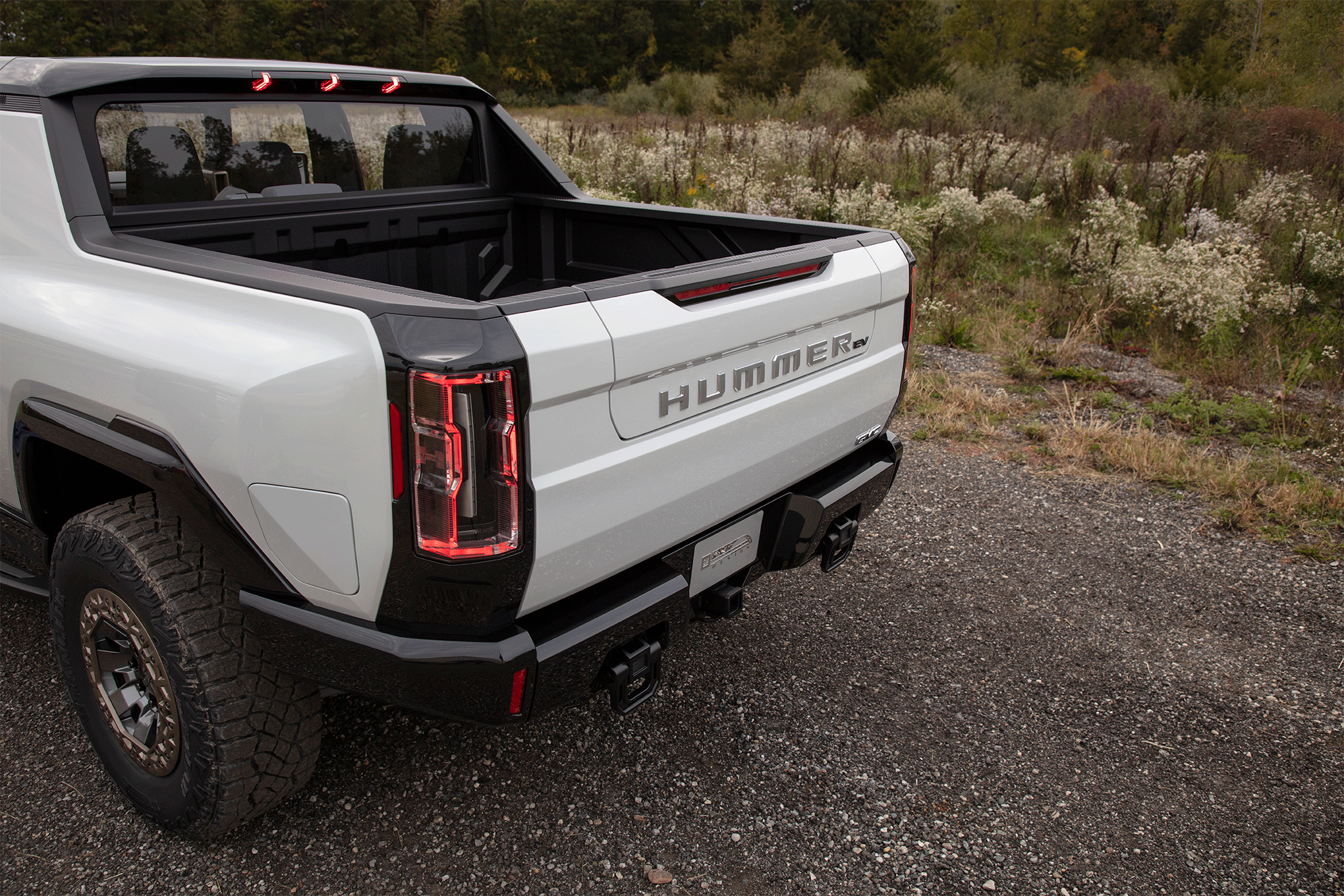
Just look at the Jeep Gladiator Rubicon. It's basically just a Wrangler with a tiny five-foot bed behind its C-pillar, but those five feet brings the truck to 218 inches in length (longer than the Hummer EV!) and drops the breakover angle to 20.3 degrees and the departure angle to 26.
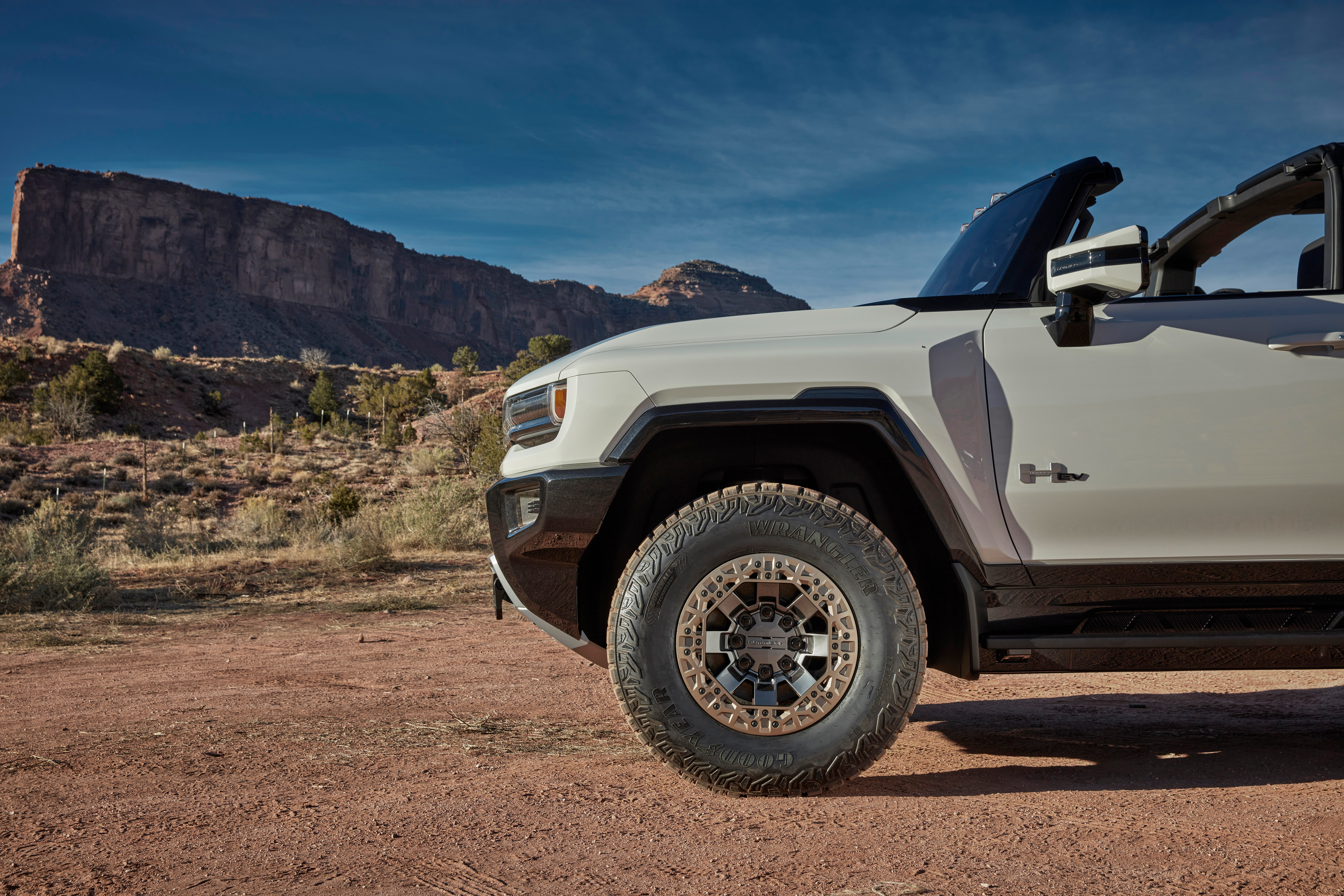
So the Hummer EV is basically as long as a larger midsize truck, but — strangely — wider and taller than even heavy duty pickup trucks. Yet because of the air suspension and short overhangs, it has off-road geometry competitive with even the most capable SUVs.
I see size being the Hummer's biggest hindrance off-road, but outside of tight spots like dense woods and boulder fields, I bet it will excel.
Underbody Protection, Articulation
Of course, there's much more to off-road performance than just geometry. Underbody protection and suspension articulation are also important. In the former area, Hummer seems to have everything covered. As shown above, there's a bash plate at the front of the vehicle likely protecting its steering and cooling components. You can also see the optional rock sliders protecting the rocker panels
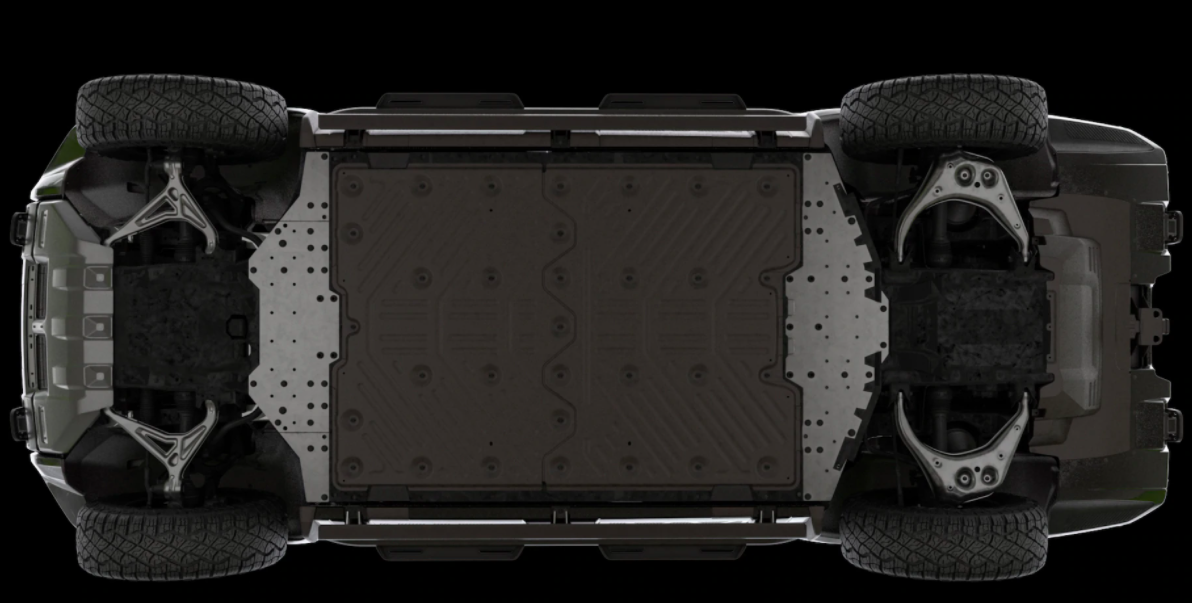
GM says the optional underbody armor consists of "five skid plates/rock sliders and two underbody shields to protect the battery pack, drive units and more." The wording there is a bit confusing. Do the rock sliders count as two of the five? I would guess so. But what are the two skid plates underneath?
In any case, looking at the image above, it's clear that everything appears to be well protected, with the control arms being the only potential vulnerability. The aluminum drive units appear to be covered:
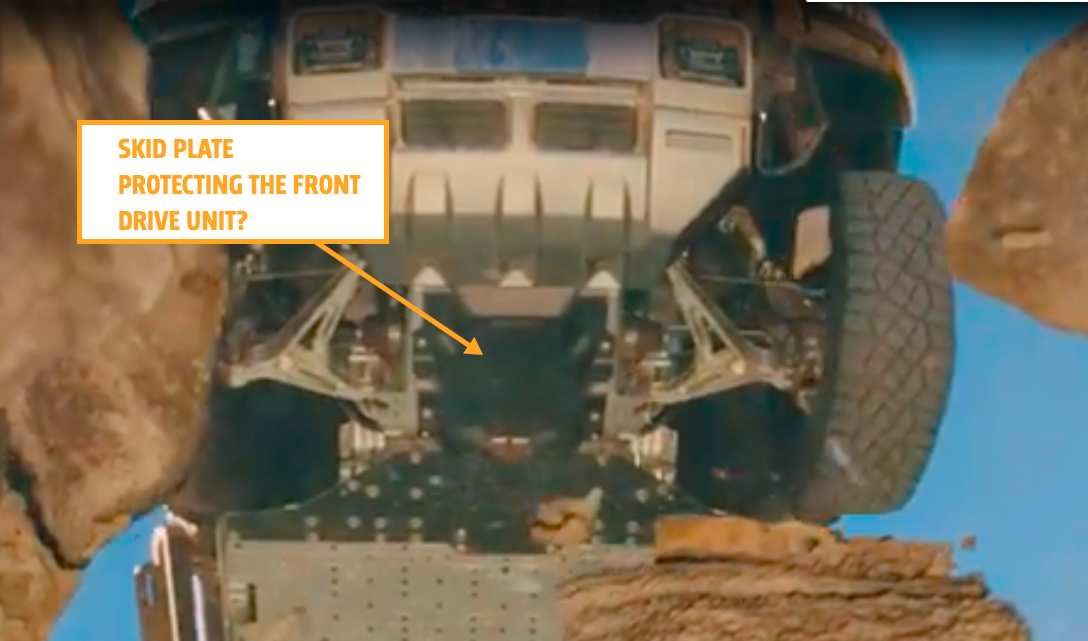
There's what appears to be a black, most likely steel, plate in the center of the front axle. I'm going to assume that's a skid plate for the front drive unit, which looks like it would otherwise be exposed from below per Engineering Explained's video. Here's a screenshot of that:
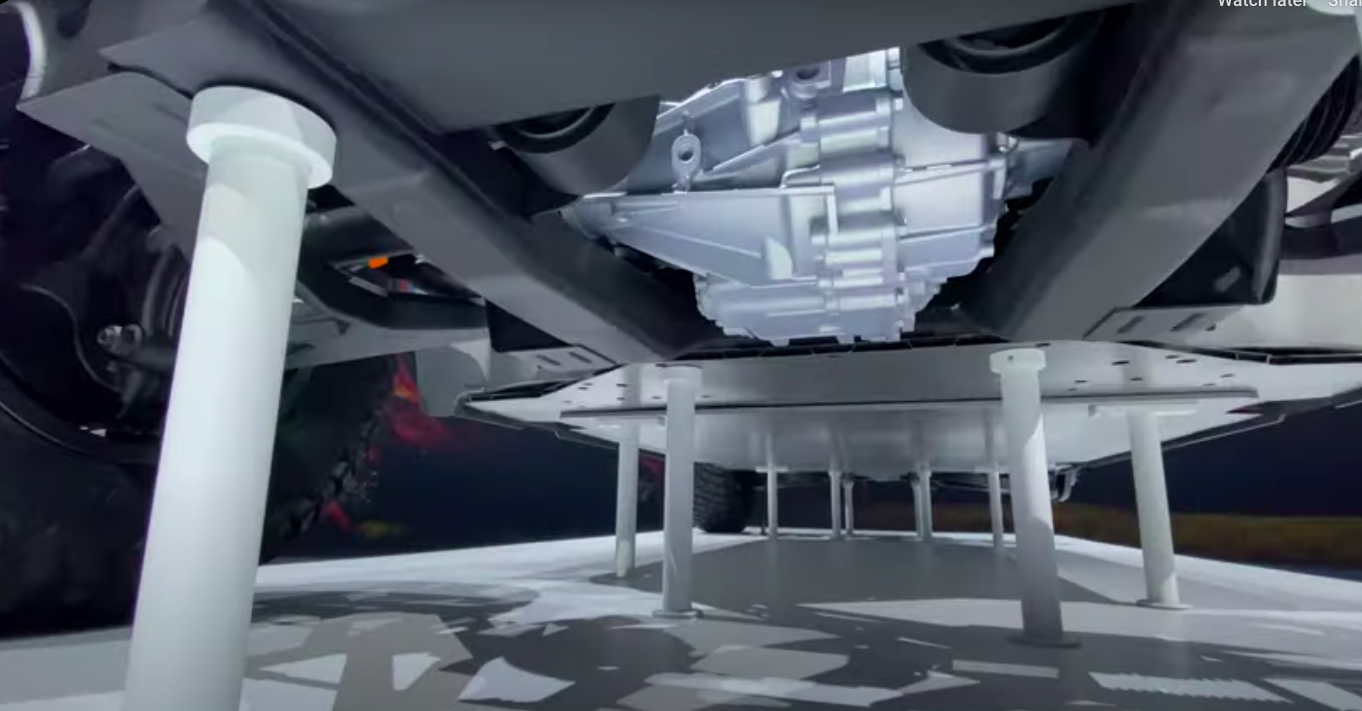
Not shown in the underbody images (or at least, I can't see it) is UltraVision, which is GM's name for underbody cameras that should help drivers navigate off-road terrain without suffering too much body damage. GM describes the system this way:
[UltraVision] includes new front and rear underbody cameras with live "virtual spotter" views to help drivers navigate obstacles and place wheels on and off the trail. The underbody cameras are specially packaged to help protect against damage and equipped with a wash function to help remove debris. HUMMER EV offers a best-in-class total of 18 available camera views6 from the vehicle, helping increase awareness of surroundings, serving as a virtual spotter
As for articulation, the Hummer EV's short-arm fully independent suspension setup doesn't really lend itself to extreme articulation, though 13 inches of wheel travel is quite good. It's actually right in line with the Ford Raptor's front suspension.
Aiding in that area is what GM calls "heavy-duty ball-spline halfshafts," shown in the clip above. GM included an example of such a halfshaft for journalists to see. You can check out the YouTube video by JerryRigEverything to take a peek at it, or you can take my word for it that it looks pretty much like the one Chevy offers for the Colorado ZR2:
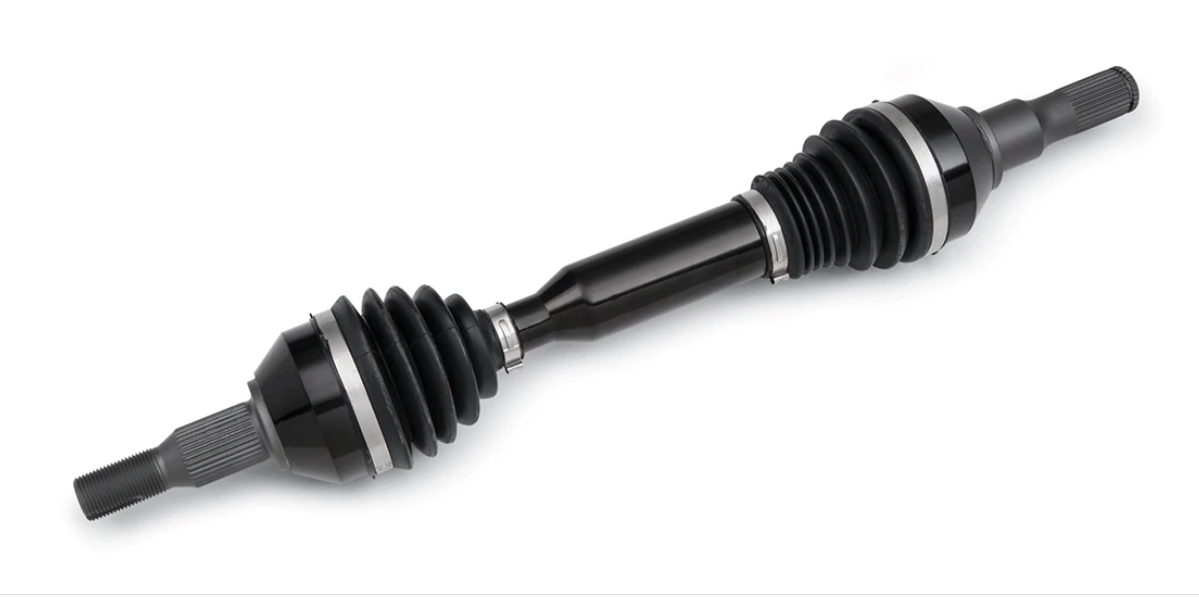
An example of a cutaway of such a ball-splined shaft can be seen below. This one is made by auto supplier GKN:
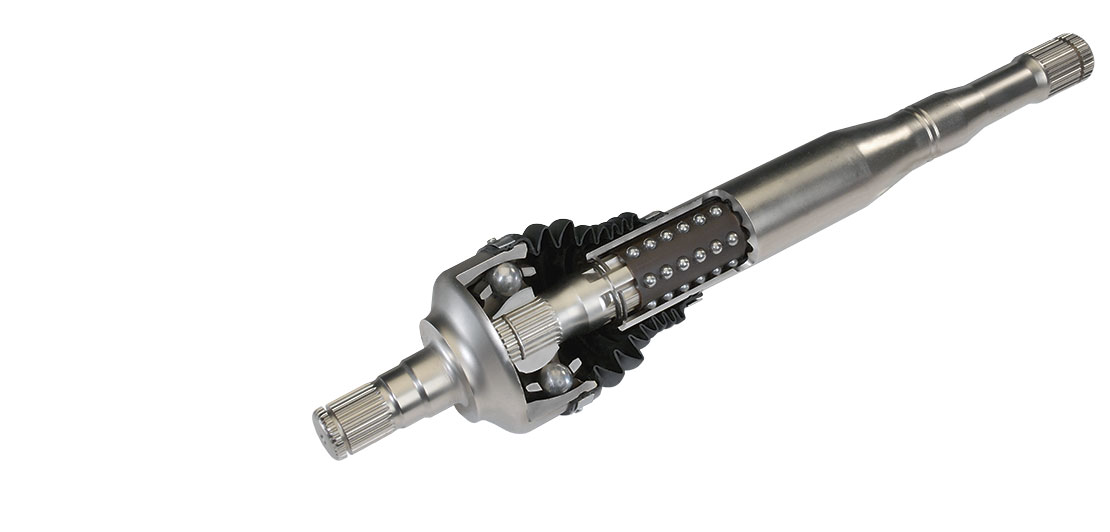
On many vehicles, plunge — which is defined as axial motion of the shaft that occurs during wheel travel — is accomplished by a tripod-joint on the differential-side of the halfshaft. You can see how those work by watching this greasy fool on YouTube:
As I understand it, the difference with the ball spline is that the inner joint is a more traditional ball-style CV joint that allows articulation but does not plunge. All the plunging happens along the length of the shaft itself. This setup, to my understanding, should allow for greater CV angles than shafts with plunge-style joints.
GM offers such halfshafts for Chevy ZR2 owners, promising that the shafts can offer more articulation and that they can reduce axial forces on the driveline, since the balls allowing for plunge are low-friction elements. Here's Chevy's description of the aftermarket shafts:
Chevrolet Performance ZR2 Ball Spline Half Shafts feature fixed inner and outer Double Offset Joints and a plunging Ball Spline Shaft allowing for larger joint angles compared to production ZR2 half shafts, accommodating lifted or leveled 2017+ Colorado ZR2 models. These half shafts provide improved articulation while reducing feedback forces through the steering system during hard cornering and off road events. Designed and validated for severe duty off-road events where speeds and loading conditions are pushed to extremes.
“Locking Differentials”
The three-motor Hummer EV has one one differential, up front, serving as a way for the single motor to drive both front wheels at different speeds for smooth operation when cornering. That diff is not only capable of varying motor output between the front wheels, it also has an electronic locking function to ensure that the front wheels spin at the same rate. This is advantageous off-road compared with an open differential, which would spin one wheel while the other remained stationary in situations where there is a significant difference in available traction between the front tires.
In the rear, there are two motors, each driving an individual wheel. The Hummer EV can vary the output of those motors quickly to maximize traction, or it can replicate a locking differential found on most hard-core off-road vehicles by setting the two rear gearbox outputs to the same angular velocity.
Here's how GM describes it in its press release:
The single-motor front drive unit will have a 13.3:1 fixed gear ratio and will offer an electronic lockable differential, capable of delivering up to 100 percent of the motor torque to one wheel, in case traction is lost on the opposite wheel. All four wheels can be fully synchronized for true e4WD propulsion.
Two rear motors contained in one Ultium Drive unit will independently power the rear wheels through a fixed gear ratio of 10.5:1, with the capability of varying torque output to each wheel to optimize traction in off-road driving and highway-driving conditions. Motor output can also be synchronized to simulate a locking differential.
Drive Modes, Regenerative Braking, Super Cruise
One of the unique things about the EV driving experience compared with that of an ICE vehicle is the feeling of regenerative braking, which can slow the vehicle down, even when you're not using the brakes, in order to charge the battery. This is often called "one pedal driving."
GM discusses how it gives drivers a choice to dial in regenerative braking to alter how much the vehicle decelerates when the driver has lifted off the accelerator. The company calls its adjustable regenerative braking system Regen on Demand, describing it in a press release this way:
Regen on Demand allows the driver to decide when and to what extent the system should be used. With the pull of a steering wheel paddle, drivers can even slow the vehicle to a full stop without engaging the brake pedal. If the driver anticipates the need to decelerate the truck, he or she can engage Regen on Demand before lifting off the accelerator pedal, for a greater measure of control.
The company mentions a one-pedal driving setup calibrated specifically for off-roading:
HUMMER EV also features one pedal driving1 through a driver-selectable Terrain Mode, which provides low-speed, one-pedal control for driving over off-road terrain and obstacles.
[...]
Terrain Mode will offer two braking calibrations, with a mild braking option for two-foot driving and a purpose-designed one pedal driving control in low-speed off-road driving. As pioneered by GM for other electric vehicles, one pedal driving enables the driver to accelerate and decelerate using only the accelerator pedal. With Terrain Mode, that same one pedal control is adapted with unique calibrations for speed-limited off-road driving, allowing the driver to negotiate steep grades, rock crawling and other challenging terrain without having to toggle between the accelerator and brake pedal.
The driver simply modulates his or her foot on the accelerator to control speed over the terrain or obstacles, even bringing the vehicle to a stop.
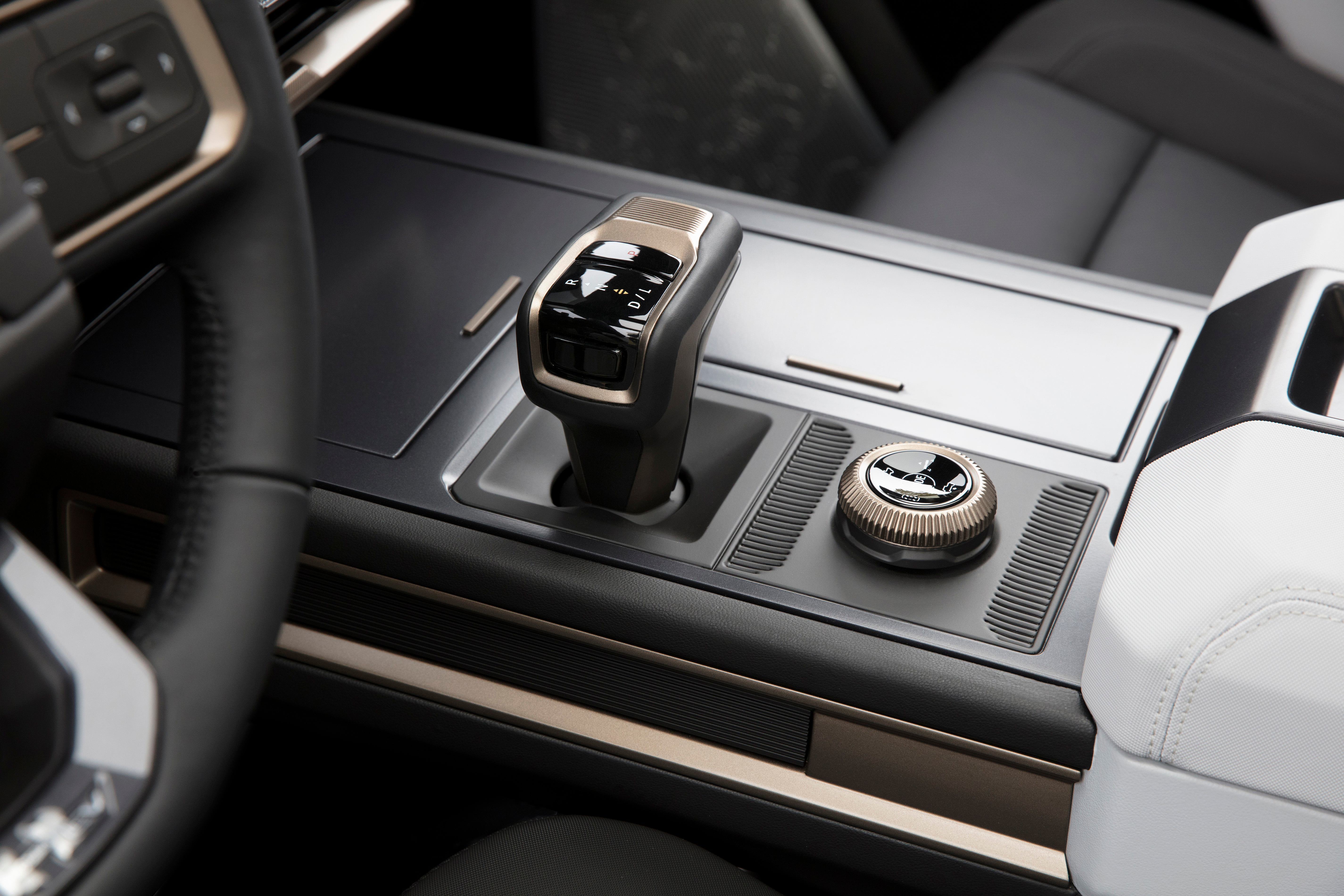
In addition to regenerative braking modes, there are driving modes — five, to be specific. The driver can configure one of those five, and the other four are Normal, Tow/Haul, Off-Road and Terrain. GM describes what parameters the vehicle can change when the driver chooses a new mode:
HUMMER EV's Drive Mode Control's five drive modes — four pre-configured modes and the driver-configurable My Mode — will enable the driver to tailor the vehicle's performance, including torque distribution, four-wheel steering, ride height, shock damping, throttle maps, brakes and interior sound enhancement
Speaking of different drive modes, we've got to discuss Watts To Freedom. This peculiar name is what GM calls launch control, which unleashes the full 1,000 horsepower motor output, and should, GM claims, get the vehicle from a stop to 60 mph in three seconds flat.
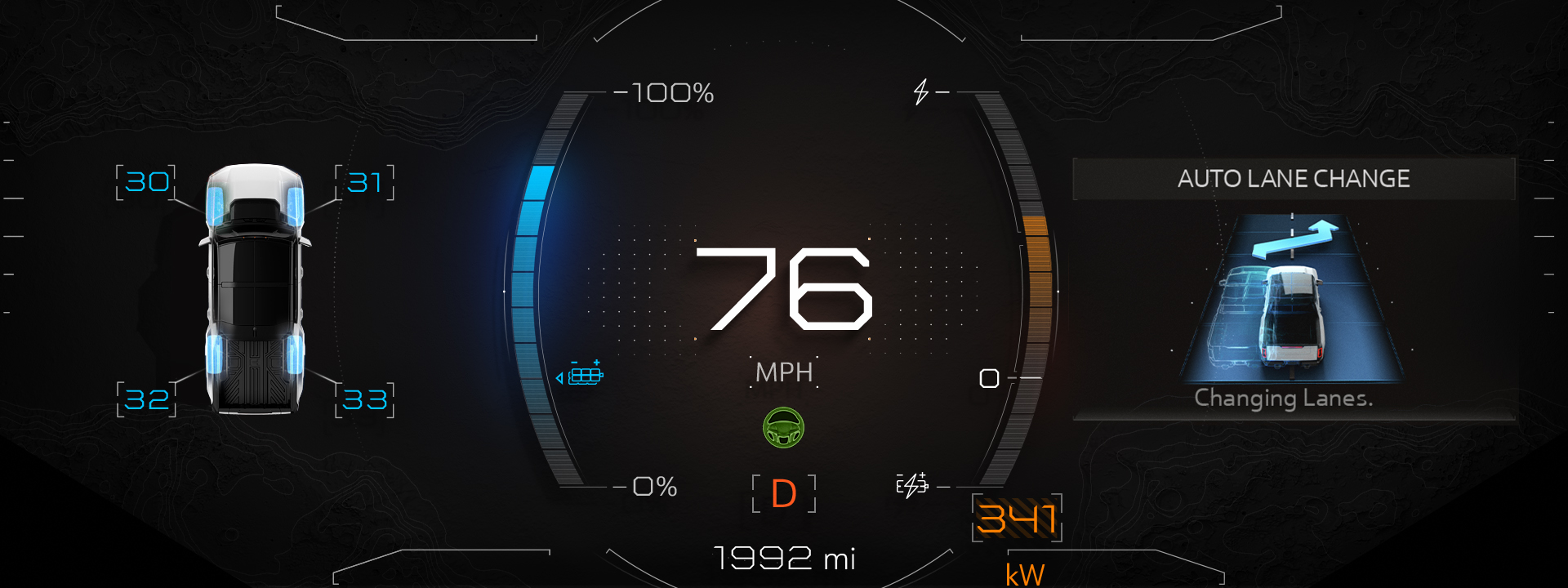
And then there's Super Cruise, which is a driver-assist feature that among many other things, allows for some hands-free driving. Super Cruise also brings an automatic lane changing feature that "[determines] when a lane change is optimal and initiate the maneuver, while following signaling protocols." This advanced driver-assist system debuted in the Cadillac CT6 and is gradually being rolled out on other GM models.
There’s Still So Much More To Discuss
As I made clear at the start of this article, this is not one of my patented "hadal" deep-dives. I spoke with only a few engineer colleagues and largely pulled information from secondary sources and GM press materials instead of talking directly with GM engineers. This means there's still a lot more to learn.
How are the motors/controllers/batteries cooled? What do the cooling channels look like inside the pack? Is the Hummer EV's body made entirely of aluminum? How do you drop the battery pack to service modules? What does that rear steering rack look like? What's the maximum charging power, and how much of the battery capacity is usable?
I could go on and on.
I'll either update this article or write a new one when I get a chance to talk with GM's enginerds.
